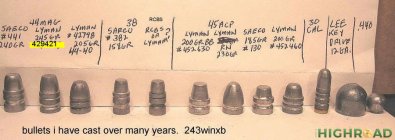Nice offer Rich!
Twds the OP;Once in awhile a new caster can find the golden horseshoe.....but most often it takes dogged determination,development time,lots of reading/study,and patience.The rewards?Different definition of success for everyone,one guy might be happy not leading up a barrel and blasting buckets of "cheaper" ammo.Next guy maybe looking at competition needs.Next guy needs premium hunting fodder?Define what you call success and engineer twds that goal.
In my pea brain casting is like using my Gma's cast iron skillets from the early-mid 1900's.Get the heat just "so",along with great ingredients and,it's magic.
Twds the OP;Once in awhile a new caster can find the golden horseshoe.....but most often it takes dogged determination,development time,lots of reading/study,and patience.The rewards?Different definition of success for everyone,one guy might be happy not leading up a barrel and blasting buckets of "cheaper" ammo.Next guy maybe looking at competition needs.Next guy needs premium hunting fodder?Define what you call success and engineer twds that goal.
In my pea brain casting is like using my Gma's cast iron skillets from the early-mid 1900's.Get the heat just "so",along with great ingredients and,it's magic.











